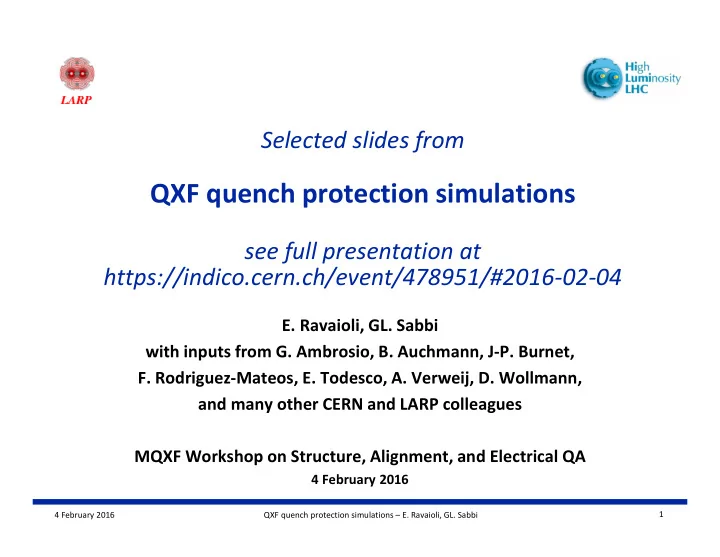

Selected slides from QXF quench protection simulations see full presentation at https://indico.cern.ch/event/478951/#2016-02-04 E. Ravaioli, GL. Sabbi with inputs from G. Ambrosio, B. Auchmann, J-P. Burnet, F. Rodriguez-Mateos, E. Todesco, A. Verweij, D. Wollmann, and many other CERN and LARP colleagues MQXF Workshop on Structure, Alignment, and Electrical QA 4 February 2016 1 4 February 2016 QXF quench protection simulations – E. Ravaioli, GL. Sabbi
CLIQ configuration -1 6 CLIQ units and 6 warm diode strings per triplet 4 CLIQ units and 4 warm diode strings per triplet Less CLIQ units, parallel elements, parallel leads. But change of the electrical order of Q1/Q3 required, and peak voltages to ground in Q1/Q3 increased. 2 4 February 2016 QXF quench protection simulations – E. Ravaioli, GL. Sabbi
CLIQ configuration -2 6 CLIQ units and 4 warm diode strings per triplet Electrically equivalent to the previous 6-CLIQ configuration, but voltage to • ground greatly reduced in the case of misfiring of one CLIQ unit Hence, additional current lead between the 2 magnets of Q1/Q3 not needed • All parallel elements can be installed to the leads already foreseen for the trim • power supplies Polarities of the CLIQ units is a key ingredient! (QA, testing at 50 V) • All CLIQ units have the same capacitance (easier to design, manufacture, • maintain the units). Units connected to Q1/Q3 can be charged to a lower voltage (600 V? 800 V?) Warm diodes are preferred over resistors (no leakage current during ramps, • better control of the voltages to ground in failure cases) 3 4 February 2016 QXF quench protection simulations – E. Ravaioli, GL. Sabbi
Coil to heater voltage optimization CLIQ and QH are triggered simultaneously. It is important to choose a QH • connection scheme that compensates the voltages induced by CLIQ and QH LF2 LF3 HF2 HF3 Q2a/Q2b case Peak coil-to-QH voltages ≤500 V HF4 HF1 IN2 IN3 IN1 LF4 LF1 IN4 IN1 LF1 IN4 LF4 IN2 IN3 HF1 HF4 Peak coil-to-QH voltages ≤500 V HF2 HF3 LF2 LF3 4 4 February 2016 QXF quench protection simulations – E. Ravaioli, GL. Sabbi
Proposed QH connection scheme Assuming each QH supply is connected to 2 strips in Connection scheme that • series (other options are possible) compensates the voltages LF2 LF3 induced by CLIQ and QH HF2 HF3 Connecting in series 2 • strips attached to different poles reduces the effects of failures (hot-spot HF4 HF1 temperature, voltage IN2 IN3 distribution) IN1 LF4 LF1 IN4 Other options are possible: Connecting an individual • IN1 IN4 LF1 LF4 QH supply to each strip (more expensive, more IN2 IN3 redundant) HF1 HF4 Connecting in series 4 • strips attached to two adjacent Q1/Q3 magnets Only half of the (less expensive, less redundant) circuits shown HF2 HF3 LF2 LF3 5 4 February 2016 QXF quench protection simulations – E. Ravaioli, GL. Sabbi
Open questions Open question Option 1 Option 2 Option 3 How many main power supplies per triplet? 2 PC 1 PC Slow circuit discharge Free-wheel 2-quadrant PC Energy-extraction system? YES NO 6-CLIQ, 4-CLIQ, 6-CLIQ, CLIQ connection 6 Diodes 4 Diodes 4 Diodes Type of parallel elements None Warm Diodes Warm Resistors Same C, Same C, Different C, CLIQ parameters for the units of Q1/Q3 Same U0 Different U0 Different U0 Full CLIQ Reduced CLIQ Level of redundancy - CLIQ capacitance capacitance Trigger Out-HF, Trigger Out-HF, Level of redundancy - QH Trigger Out-HF Out-LF, In QH Out-LF QH connection scheme Failure cases to consider Specifications CLIQ terminals/leads 6 4 February 2016 QXF quench protection simulations – E. Ravaioli, GL. Sabbi
Recommend
More recommend